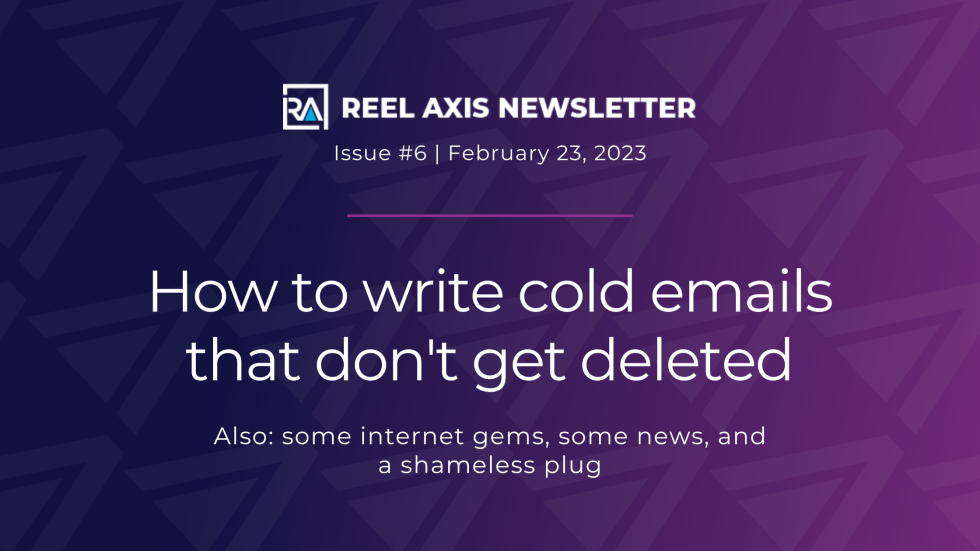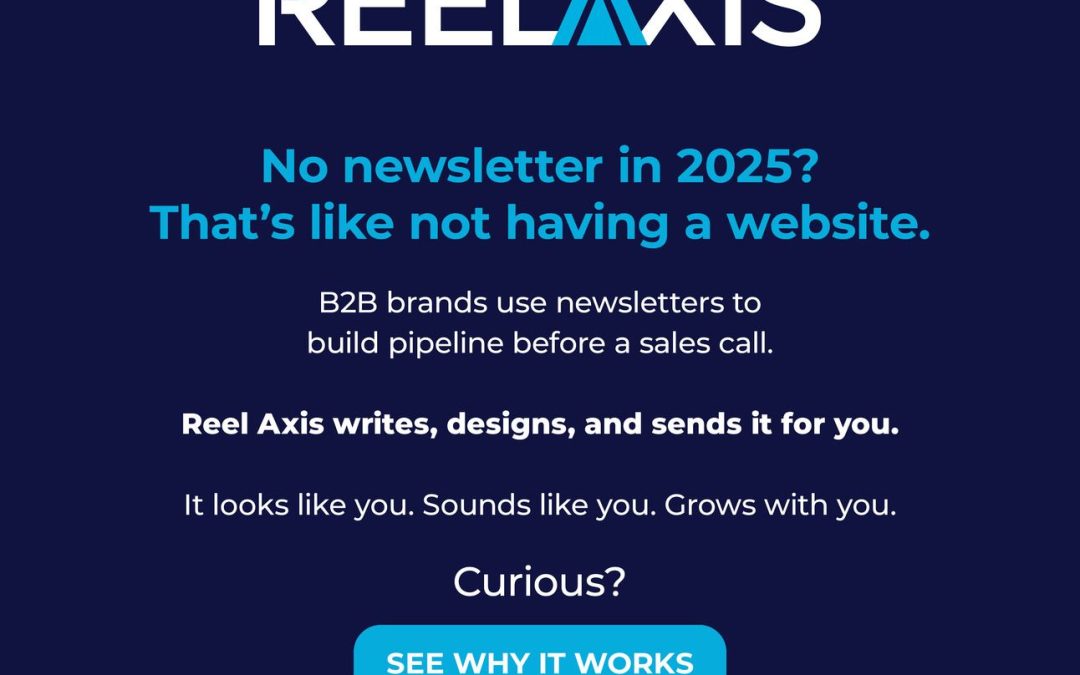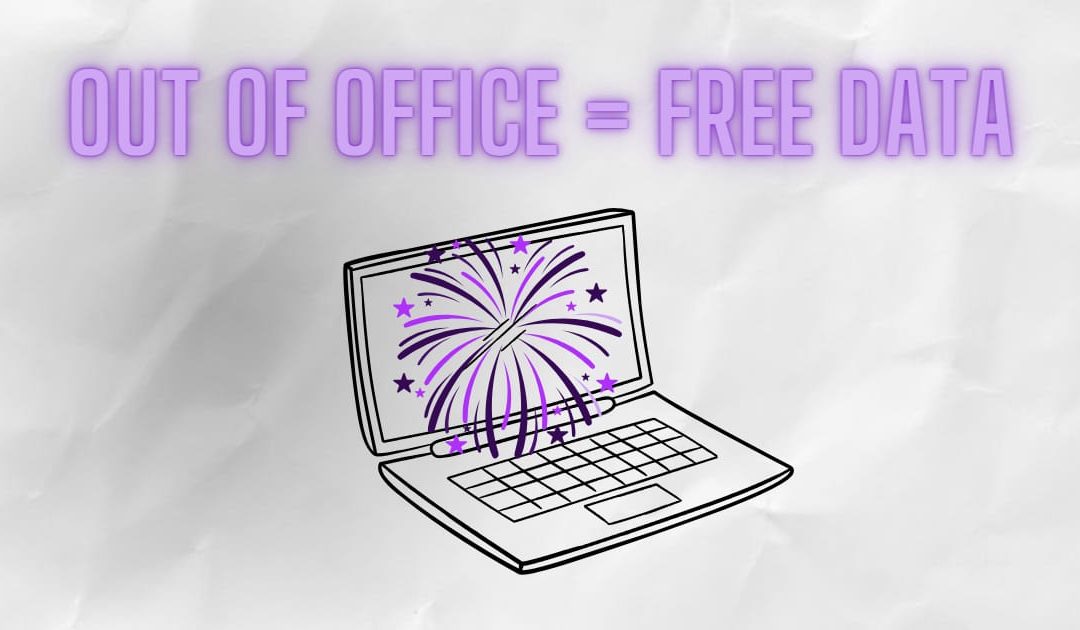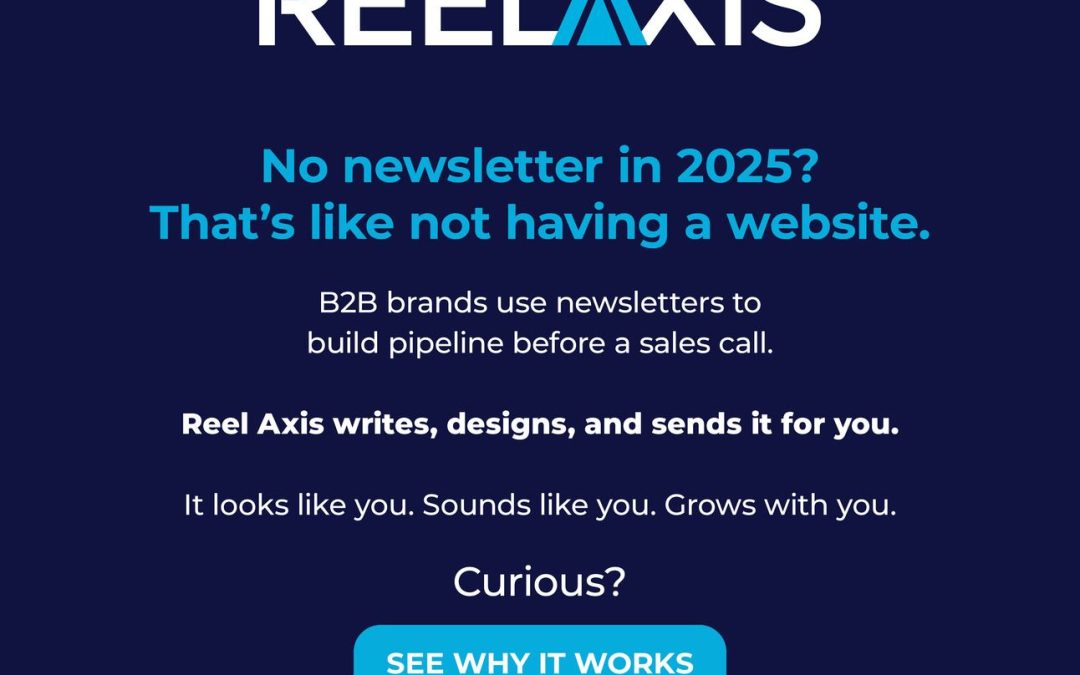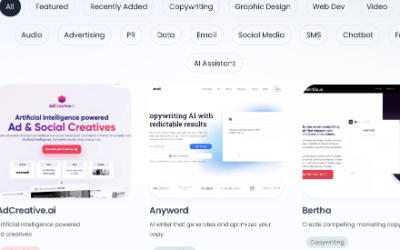Here’s what we cooked up for you this week:
- How to write cold emails that don’t get deleted. We break down an example of a bad cold email vs. a good one — line by line so you can see what works and what doesn’t. Steal the good stuff. Ditch the bad stuff.
- Some internet gems we found. Something to make you laugh, something to make you think, and something to make you some money!
- A shameless plug. We got featured in a Canva article about visual collaboration and how we do it the Reel Axis way. We hope you’ll check it out, but if you’re busy, no hard feelings.
And away we go…
✉️ How to write cold emails that don’t get deleted
If you’re like us, then your morning’s probably look a little something like this.
You sit down at your computer with your coffee. Login. Open your email and settle in to sift through the dozens or maybe even hundreds of emails that came in since you signed off of work the evening before.
Some of the emails are important. But a lot of them aren’t. And one thing is guaranteed… a lot of them are cold emails from someone you don’t know trying to sell you something.
If getting pure sales emails isn’t bad enough, what’s even more annoying is how badly most of these emails are written. And we mean really badly!
Here’s a perfect example of one that just came in this morning.
Example of a horrible email
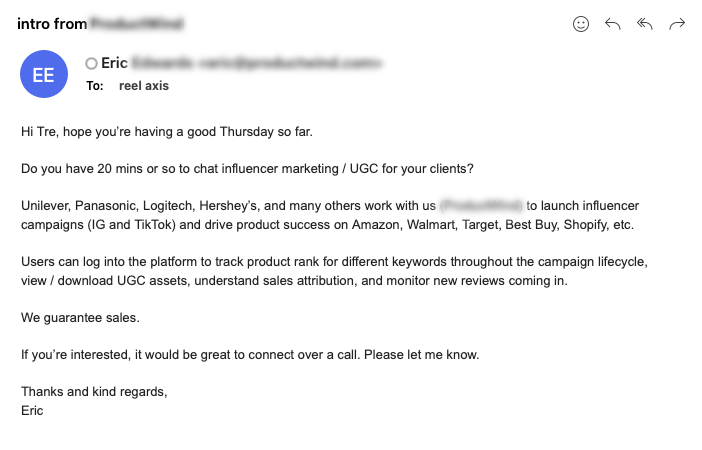
Let’s break down why this is a terrible cold email line by line…
Subject line

One of the most important elements of email marketing is writing a great subject line. This email’s subject line is wasted real estate.
It’s not attention-grabbing. It says “intro,” immediately tipping off the reader that this is a sales email. And it has the sender company’s name in it. Unless your company has widespread name recognition that would cause someone to click, the company name doesn’t belong in the subject line of a cold email.
How to fix it
Instead, Eric should have written a subject line that piqued interest or captured attention. The point of a subject line is to get someone to open the email. Write something that stands out among the sea of emails in their inbox.
Remember a few newsletters ago when we wrote about good hooks? Think of your subject line as your hook.
A better subject line might have been:
– How Panasonic made $2M with one UGC campaign
– Stop running influencer campaigns with bad analytics
– Influencer marketing for B2B companies
We’ll also take points off because this email was sent to the Reel Axis distribution list, not an individual’s email address. If you’re sending a cold email asking for a 1-on-1 meeting, don’t send it to a group of people.
Greeting

This email committed the cardinal sin of email marketing. He got the first name wrong! No one named Tre has ever worked at Reel Axis.
I’m sure we have all gotten sent a cold email that made this mistake. What was your reaction? We would wager a guess that it left a bad taste in your mouth.
This is the kiss of death for an email campaign. It doesn’t matter what you say after, you’ve already lost all your credibility. It shows the sender lacks attention to detail and is lazy. No one wants to work with someone like that.
Getting someone’s first name correct is the lowest-hanging fruit that there is for an email campaign. Most cold emails are automated. It’s not much work to set them up. So the least you can do is make sure the list you upload has the correct data.
How to fix it
Make sure the contact fields of your list are mapped correctly and that your data is up to date.
Opening Line

Eric commits another big email mistake here — he immediately asks for a meeting. He’s provided no value or incentive to meet. We don’t know anything about him or his company yet. How could we possibly know if we’re interested in meeting?
People’s time is extremely valuable. Asking someone to give up 20 minutes is asking them for a huge favor. It’s bad form to ask someone for a huge favor when you’ve provided them no value in return.
Would you walk up to someone you’ve never met, shake their hand, and say, “Nice to meet you! Now can I have 50 bucks?”
Of course not. But if you send an email like this, that’s exactly what you’re doing. If you’re emailing a company’s decision-maker, 20 minutes of their time is probably worth $50 at the least.
If you wouldn’t expect them to pull out their wallet and hand you a 50. Don’t expect them to agree to a 20-minute meeting.
How to fix it
Provide value to the reader before you ask them for something. Teach them something, entertain them, inspire them, etc.
Ideally, you send them multiple emails that all provide value before you ask them for something in return. The goal of a cold email should be to get a conversation going with a contact. Not to get a meeting right off the bat.
If you don’t want to wait to send multiple emails, then at least have a call to action (CTA) that doesn’t take much work on the recipient’s part. We call this a soft CTA.
A soft CTA is something that the recipient can respond to in one line, or better yet, one word.
Examples of a soft CTA Eric could have used:
– Can I send you a PDF of our influencer marketing campaign checklist?
– Are you running any influencer or UGC campaigns at this time?
– How do you currently track influencer marketing campaigns?
Which do you think is more likely, that someone takes 10 seconds to respond to one of these questions or that someone agrees to a 20-minute meeting? No brainer.
Social Proof

Eric is using a pretty common tactic with this line. He’s providing social proof. However, he makes another key mistake here — the company examples he gives are nothing like Reel Axis.
All of his examples are large B2C product companies that sell through retailers. Reel Axis is a service-based SMB that serves B2B tech companies.
If he really has had wins with the companies he listed, good for him. But they have totally different business models than Reel Axis. Why would we think that what worked for them is the same as what would work for us?
How to fix it
Do a little bit of due diligence and make sure that any examples you provide are actually relevant to the person you’re emailing.
If Eric had given an example of how he helped another marketing agency drive positive results, maybe we would have given him the time of day.
If you’re trying to break into a new industry or vertical and you don’t have relevant examples yet, then at least show that you understand the recipient and their business. Talk about the pain points they face and some possible solutions to fix them. Or mention a desired outcome and walk them through how you can help them achieve it.
Product Info

Another fairly common mistake here. Eric is listing off features of the product instead of addressing outcomes or pain points.
In a first-touch email, it’s much more effective to sell benefits, not features. Your audience cares about what your product/service can do for them. Not how you do it.
How to fix it
Eric should have illustrated why his product made previous clients’ lives easier or better.
Examples of benefits Eric could have highlighted:
- I spoke to a new client last week and he told me that he used to spend 6 hours per week manually reporting on influencer campaigns. Since using XYZ product, he’s cut that down to 30 minutes per month!
- ABC client was able to double the number of UGC campaigns they ran in Q4 because our UCG content manager let their new affiliates do self-serve onboarding.
- Since they had review monitoring turned on, ACME company saw a 1-star review within 5 minutes of it being posted. They were able to call the customer and resolve the situation right away. Because of the quick customer service, their client changed the 1-star review to a 5-star review before the day was over.
Ok, I think we’ve beaten up poor Eric enough! Let’s change gears and break down a good cold email.
Example of a great cold email
Here’s an example of a cold email our CEO, Chris, received a couple of weeks back. Is it perfect, no? But is it head and shoulders above what we usually see? Definitely.
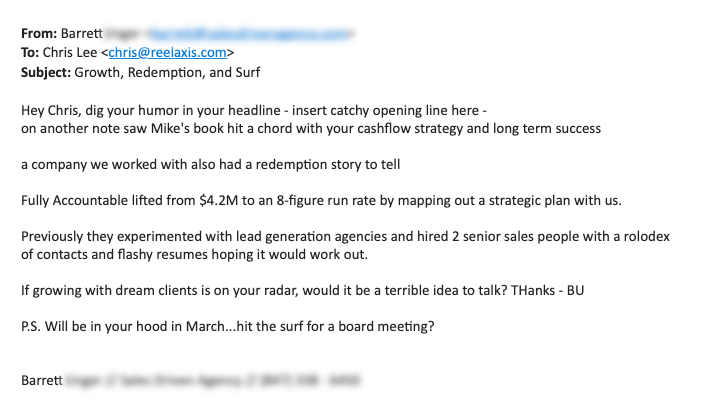
Before we dive into a line-by-line breakdown, there is one overarching thing that makes this email good. And that is: Barrett did his research.
Several lines in the email are personalized for Chris. Barrett clearly looked at his LinkedIn profile and pulled in key topics to catch Chris’ attention. It probably took him 2-3 minutes of research, but it was time well spent because it made him stand out and got his email noticed.
Let’s break down why the email is so good….
Subject line

It’s attention-grabbing… for Chris. When you read it, maybe it doesn’t mean much to you, but for Chris, growth, redemption, and surfing were the themes of his three most recent LinkedIn posts.
It’s plenty to get him curious enough to open the email.
Greeting

First and foremost, Barrett gets Chris’ name correct. A low bar, but as we saw in the example above, it’s not one that everyone can clear (sigh).
Then Barrett references Chris’ LinkedIn headline and compliments him on being funny. It’s never a bad idea to lead with a compliment. As long as it’s actually genuine. It’s easy to see through a disingenuous or generic compliment, so avoid those.
But, Chris’ LinkedIn headline actually is “Insert Catchy Headline Here.” It’s clearly meant to be humorous and poke fun at the sometimes cringy nature of LinkedIn content. Chris is signaling his sense of humor here. Barrett picks up on that and uses it as a way to relate to Chris.
Opening Line

Here Barrett shows that he went a layer deeper with his research. He’s referencing a recent post Chris made on LinkedIn. This signals to Chris that this isn’t just another automated cold email sequence.
Barrett at least took the time to dig into Chris’ background to find out what he cares about. Then manually wrote to him about it.
Social Proof

Barrett chose an example that is relevant to Reel Axis. Fully Accountable is an SMB service-based agency. What their needs and pain points were are most likely aligned with what Reel Axis’ are. If Barrett’s company could help them, why not Reel Axis too?
Closing

This is a pretty good example of a soft CTA. We’re not crazy about the fact that he’s already asking Chris for a meeting, but at least he’s doing it in a personalized way.
Again, he’s referencing a recent LinkedIn post where Chris mentions wanting to surf more this year and suggests people sync up with him to surf instead of meeting for lunch.
Even though he’s asking for a meeting, Barrett still keeps it low barrier of entry for Chris. He’s able to respond with a quick “sure” or “let’s do it” and the ball would be back in Barrett’s court. Plus, Barrett is offering to come to him for the meeting, making it easy on Chris.
The final thing worth calling out is that Barrett uses a subtle psychological trick with how he worded his CTA. He framed it in a way that if Chris doesn’t respond, he’s admitting that growing with dream clients isn’t on his radar. People don’t like the idea of that negative framing.
Even if it’s not true, the implication makes people slightly uncomfortable. Sometimes that’s enough to tip the scales and get someone to shoot back a reply.
📰 In the news this week
⏰ Here’s the best time to post on TikTok.
🤖 Will ChatGPT take your job?
🐜 Security researchers warn about Apple bugs.
🧠 38% of Marketers shift strategy from customer acquisition to loyalty.
💼 Most in-demand skills for 2023 according to LinkedIn.
💎 Some gems we thought you might like
We spend a lot of time researching, reading, and messing around online each week. Probably an embarrassing amount if we’re honest. The screen time warnings on your phone don’t really exist if you don’t look at them, right…right….?
But, the upside is that we find some interesting stuff. So this week we wanted to share a few of those gems with you.
Something to make you laugh

Something to make you think
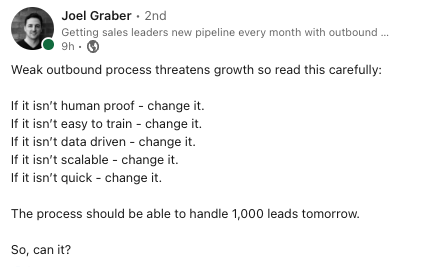
Something to make you money
The CFO of Outreach.io wrote a post that went viral on LinkedIn this week. It’s her Tips for Selling to CFOs that Every B2B Salesperson Needs to Know.
She explains:
- What CFOs actually care about
- How to negotiate with them
- How to interact with them to get the best results
It’s worth reading if you do any kind of sales, work in marketing, or ever interact with a CFO. So basically everyone should read it!
🔌 A shameless plug
Reel Axis was recently featured in an article by Canva exploring The Impact of Visual Collaboration on the Future of Teamwork.
We walked them through how we leverage visual collaboration on a day-to-day basis to help our clients.
If you work with a team or work remotely, we highly recommend you check out the full article. And no, we aren’t just recommending it because we’re mentioned (although that doesn’t hurt 😉). There are some really great examples and use cases here that you might want to integrate into your business.
Here is an excerpt:
Whether you’re creating a presentation for an internal team meeting, a pitch deck for stakeholders, or a strategic plan for a customer, visual collaboration can also be leveraged in presentations.To present and collaborate on campaign strategies with clients, Lindsay Sayre, director of strategy at Reel Axis, sets up a campaign hub using a virtual whiteboard tool. Lindsay and her team create a campaign blueprint, or a visual representation of the campaign, to present a strategy and project plan to a customer. The hub also consists of all assets and information related to the customer’s campaign.Rather than setting up a meeting, Reel Axis often sends its initial plan to the customer as a recorded presentation. Not only does this asynchronous collaboration save them a lot of time, but the visual representation also gives customers a chance to familiarize themselves with the recommended strategy in an easily digestible way.Once the customer has reviewed the strategy, they can leave feedback directly on the images, diagrams, or other visuals within the presentation. This keeps all feedback in one place and allows other team members and stakeholders to stay informed on new changes.
How’d we do with this week’s newsletter?
Enjoy this newsletter? Forward it to a friend to spread the love.
Want us to write about something specific? Submit a topic or idea.

